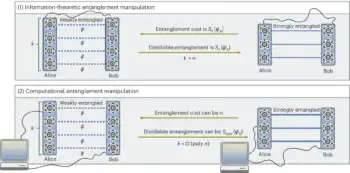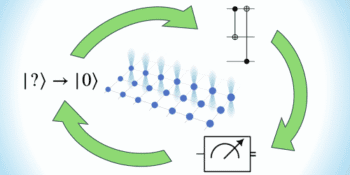The experimental observation of Bose-Einstein condensation in a gas of rubidium atoms in 1995 had a huge impact on the physics community, with reports of "a new state of matter" making newspaper headlines all over the world. By comparison, it was in relative obscurity that Simo Jaakkola and his group at the University of Turku in Finland, in collaboration with researchers at the Kurchatov Institute in Moscow, recently observed the two-dimensional analogue of the effect (A I Safonov et al. 1998 Phys. Rev. Lett. 81 4545).
Jaakkola observed two-dimensional Bose-Einstein condensation (2D BEC) in a gas of specially prepared hydrogen atoms adsorbed on the surface of liquid helium. In Bose-Einstein condensation all the particles in a system collapse into a single quantum state that has many unusual and novel properties.
Atomic hydrogen was once considered the epitome of a quantum gas, but it proved more difficult to condense than expected and has been pushed into the background in recent years by the work on alkali atoms. However, in contrast to three dimensions, atomic hydrogen has two natural advantages in the race to produce a two-dimensional condensate: it is anomalously stable and has only a very weak interaction with liquid helium. The latter property ensures that the hydrogen atoms can move freely over the surface and behave as a 2D gas.
The Turku experiment was the first to demonstrate quantum-degenerate behaviour in atomic hydrogen, and was quickly followed by a 3D demonstration by Tom Greytak, Daniel Kleppner and colleagues at the Massachusetts Institute of Technology in the US (Phys. Rev. Lett. 1998 81 3811). However, its true importance lies in the fact that it was done in a 2D geometry. Quantum degeneracy in a 2D gas, just as in the 3D case, is connected with many-particle correlations that change markedly when the interatomic distance becomes less than the de Broglie wavelength of the atoms. This wavelength increases as the atoms are cooled.
However, the theory of the 2D weakly interacting Bose gas is far more complex than that of its 3D counterpart, and is only partly understood. The special and sometimes subtle role of 2D systems is quite general in physics. These systems balance on the edge between 1D, where phase transitions are not possible, and 3D, where they are.
The physics of the 2D Bose gas of hydrogen atoms is complementary to that of thin films of liquid helium. The quantum behaviour observed in the latter system, superfluidity, is a transport property and can be well described in terms of the phenomenological theory of Kosterlitz, Thouless and Berezinski. In contrast, superfluidity is very hard to detect in a 2D hydrogen gas. Instead this system is sensitive to local (two- and three-particle) correlations and can be related to more microscopic theories that explain BEC in terms of atomic interactions. This in turn is more difficult for helium.
The essence of the Turku experiment is as follows: a buffer volume is filled with hydrogen atoms that all have their electron and nuclear spins pointing in the direction of an applied magnetic field. Such a gas is said to be doubly polarized. This gas and the hydrogen atoms absorbed onto a helium surface inside the experimental chamber are in equilibrium with each other. By cooling the walls of the chamber, or by increasing the density of hydrogen atoms in the buffer, the density of the 2D gas can be increased to the point where the condensate appears.
The truly important feature is the huge stability of the spin-polarized adsorbed gas: the only loss mechanism is the formation of hydrogen molecules in three-body collisions. The rate constant for this three-particle process is about 10 orders of magnitude smaller in hydrogen than in other systems of cold atoms. This stability is the key to success, as it allows for the accumulation of the very high surface densities needed to achieve quantum degeneracy.
If this were the whole story then a 2D BEC would have probably been observed years ago. But there is a catch: molecules are occasionally formed on the surface. Each molecule releases a total energy of 4.5 eV but, fortunately, it does so only after it desorbs from the surface. The overall result is to heat and evaporate hydrogen atoms from the surface, thus reducing the phase-space density, and the chances of producing a condensate.
One way round this problem is to reduce the effective surface area for the atoms by using strong magnetic-field gradients to confine the atoms into a small spot. The beauty of this idea, originally conceived by Yuri Kagan and Gora Shlyapnikov of the Kurchatov Institute, is that the inhomogeneous field does not affect the molecules formed in recombination events because they are non-magnetic and can therefore escape into the buffer gas. The recombination heat is thus diluted to a harmless level. In the Turku experiment the magnetic-field gradient is produced by an annular knife-edge of cobalt-iron. This knife-edge acts as a field compressor and is located just below the helium surface. The whole set-up is placed inside the bore of a superconducting solenoid. Locally, this field compressor produces a field gradient as large as 105 T m-1.
So how does one measure the surface density on the small spot, which is only about 10-3 cm2 in area, and how does one know that a condensate has been formed? The Turku group used an indirect method to tackle this problem: the surface density is monitored by injecting small bursts of hydrogen atoms that have their nuclear spins polarized in the opposite direction to the adsorbed atoms. If one of these “reactive” atoms lands on the helium surface, it will trigger the formation of a molecule. The resulting increase in the loss of surface atoms leads to an increased depletion of the buffer. The number of buffer atoms is monitored and hence the surface density on the spot can be inferred.
The presence of the condensate is revealed through its effect on the intrinsic three-body decay of the surface gas. To measure this, the injection of reactive atoms is switched off, so that the decay becomes proportional to the cube of the surface density. The rate constant for this decay is sensitive to the quantum statistics of the adsorbed atoms. Kagan and co-workers showed that the appearance of a condensate should lead to a reduction of the decay constant by a factor of six (see figure). It was the observation of a large reduction in this decay rate that convinced the Turku researchers that they had struck gold. Surprisingly, the measured reduction was even higher, a result that still awaits a satisfactory explanation.
The Turku experiment is the first to demonstrate 2D Bose-Einstein condensation in a rarefied atomic gas. Its interpretation is rather complex and the results give rise to many new questions. What is sure, however, is that the experiment has opened up an exciting new class of quantum fluids to experimental scrutiny.



